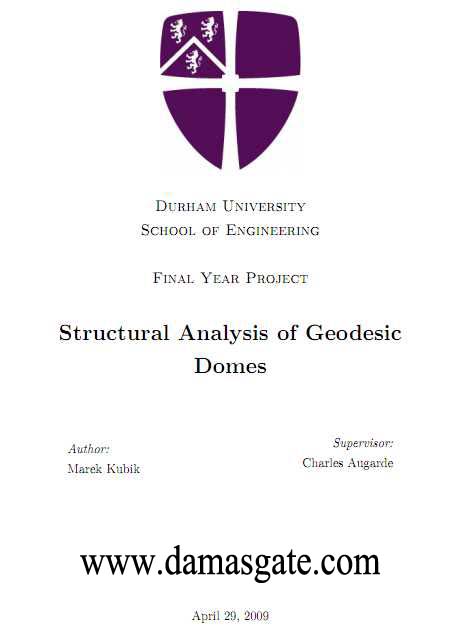Structural Analysis of Geodesic
Domes
Marek+Kubik+report

Project plan
Introduction
A project to house 40 families in the Maharashtra region of India which began in January
2005 was halted shortly after it commenced due to concerns over the loading applied to
a series of geodesic domes which form a large portion of the whole complex. The domes
had soil packed over them, a condition which was never anticipated in the original design.
The need for a method to model the structural response of the geodesic or “Pabal” dome
was highlighted by Vigyan Ashram, the Non Governmental Organisation (NGO) that
manufactures the domes; this dissertation describes the research into the Pabal dome and
the development of a bespoke finite element analysis (FEA) package capable of running
in Microsoft Excel.
Objectives
Vigyan Ashram locally produces the geodesic domes as do-it-yourself kits for the lowermiddle
class of both rural and urban populations. The original design was adopted in
the aftermath of the 1993 Killari earthquake, aiming to provide durable, low cost housing
capable of withstanding the earthquakes, rains and winds of India for those that lost their
homes.
Of the 120 geodesic dome kits supplied to the Water Bank housing project, 40 were
planned to be subterranean and were therefore affected. Vigyan Ashram, together with
another NGO, engINdia, asked for research into the geodesic dome’s current incarnation
to be carried out. The Water Bank project highlighted the need for a method of modelling
the structural response of geodesic domes, as an assessment of the loading encountered
by the domes would allow recommendations to be made as to how the design could be
adapted to accommodate the expected loading.
Vigyan Ashram’s main desire was for a structural analysis package without the associated
licensing costs, to allow their science and technology centre to assess the geodesic
dome’s structural response in-house. This would provide significant long term benefits
for Vigyan Ashram, removing the need for outsider aid with such design problems in the
future. If appropriate, students at Vigyan Ashram would also use the developed method
to further their understanding of structural behaviour.
It was hoped that a reliable method of analysis would increase the number of potential
uses of the structure and hence its market demand, benefiting both the community and
the business that manufactures the dome, which was founded and run by an ex-student
of Vigyan Ashram.
The objectives of this project may be summarised as follows.
1. The development of a method of finite element analysis for geodesic dome structures
using Microsoft Excel 2003. The program needed to provide a user friendly format
that gave the user the opportunity to define a geometry, select appropriate material
properties and apply a variety of loading conditions. It was required to output
information about nodal displacements and forces in the elements.
2. The assessment of the dome joints used in the structure to determine their design
limits. Based on these findings, a relationship between material parameters and the
ultimate failure strength of the connections was to be developed.
3. The development of an additional spreadsheet that would allow the user to calculate
all the relevant dome fabrication details - how many different struts are required,
how long they are, how many bolts are required for sufficient connection strength
etc.
Project timeline
This project was to be carried out over a period of 28.5 weeks - from the end of September
through to mid-May. A Gantt chart breakdown of the project plan may be found in
Appendix A, with all the major project deadlines highlighted.
Work was broadly categorised into three phases.
- Phase I: Initial research and planning; lasting from September through to January,
culminating in the submission of the literature review. In this phase, background
reading and discussion with Vigyan Ashram would lead to the development of a list
of objectives and a project plan. Additionally, preparation work for the later tension
testing work would be scheduled, including the submission of a risk assessment and
the production of engineering drawings to fabricate the required dome joints.
- Phase II: Data collection; overlapping with Phase I, from December to the end of
April. Here, experimental work would be carried out and the spreadsheets developed,
culminating in the submission of a draft version of the final report.
- Phase III: Project conclusions; from April until the concluding oral exam in May.
Upon return of the draft report from the project supervisor, modifications would be
made and the final project submitted on the 29th of April. Additionally, a poster
design for display in the department would be produced and preparation for the
oral exams would occur in this period.
Download
http://s18.alxa.net/s18/srvs2/01/Ma...bik.report.rar